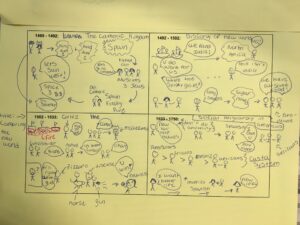One of the most challenging problems history and social studies teachers face is managing the enormous scope of content that we are responsible for teaching. One teacher we worked with a few years ago referred to that content as “a behemoth.” The Four Question Method gives teachers a way to tame that behemoth: by focusing on the story of the unit and choosing “representative events” to tell it.
Story First, With Representative Events
Gary and I are currently writing an elementary school unit on the Renaissance for Nashville Classical Charter School in Tennessee. The school uses the Core Knowledge Foundation’s history and geography text, which is lively and well written. It also includes nine chapters on the Renaissance, with a total of eighty nine pages of text. As I said, this is a good textbook: it’s clear, coherent, and does a good job explaining historical events — none of which are givens among textbooks in our field. But can we really expect nine and ten year olds to remember all the artists and popes and places listed in these eighty nine pages? We cannot. And if we actually tried to teach all that content, we’d crowd out all the time for students to practice their own historical thinking: the kids would have no time for the skills of narration, interpretation, explanation, and judgment. We need to pare down the list of content in our unit, but we need to do it in an efficient way that has positive effects on student learning.
At 4QM Teaching we say that social studies teaching starts with “Story First.” The key to paring down your content is deciding what story your unit will tell. Every historical event that makes it into our curriculum is big and complicated — there’s a lot you could teach, and there are many different ways you could construct your narrative. But you only have one school year for all your content, so you’ve got to decide which story you’re teaching this year.
An important way to tame your story is to choose a small number of “representative events” to focus on. Most big historical stories have a lot of similar events in them. Wars have many battles. European imperialists conquered many places. The thirteen American colonies protested many English policies during the 1760s and 1770s. Don’t make your students learn all of them to the same depth. Choose one or two that are important and can represent all the others, and focus on them — then tell your students that there were others that were similar in most key respects.
Florence: Cradle of the Renaissance
The nine Core Knowledge textbook chapters on the Renaissance include three on specific cities: Florence, Venice, and Rome. We decided to only teach Florence. It’s a great representative event for our unit story. Merchants become wealthy through trade (in the case of Florence through the wool trade), expand their business into banking, and use their wealth to explore classical learning and patronize artists. Our choice of Florence also helped us to decide what specific artists to include in the unit. We’re only holding students responsible for da Vinci and Michelangelo, both of whom had strong connections to the city. We can tell students that there were other Italian cities that followed a similar pattern to Florence, including Venice and Rome. But we don’t have to read those chapters and teach those cities, or their artists. (I was sad to have to cut Titian, a Venetian master whose work I love. But unit planning for kids should be built around a lean story, not including everything their teacher loves. We’d never get through the school year that way.)
Time For Student Thinking
Choosing representative events to tell your unit story buys your students the time they need to practice historical thinking skills for themselves. We’re planning a day to teach the story of Florence, and then a day to have students use storyboard cards to tell the story back to each other. Historical narration is a very challenging skill, especially for students learning something for the first time. If we were rushing from Florence to Venice, the students would not have time to practice telling either story for themselves, and only the most capable students would remember both stories a week or two later.
Of course our unit goes well beyond narration. We’re going to have kids do a drawing exercise on perspective, and interpret da Vinci’s Last Supper and a detail of Michelangelo’s Sistine Chapel ceiling. We’re building a Question Three puzzle on why the Renaissance spread where and when it did (trade!), and a Question Four discussion class on vanity. We’d never be able to do all that if we were actually assigning all nine chapters in the textbook.
I’ve written about cutting unit content before, and in our book we describe the 4QM unit planning process in much more detail. The bottom line is that social studies teachers always have to select a story from among many, which means they have to decide what not to teach. Selecting representative events to carry your unit story is a great way to make those decisions.
J.B.


